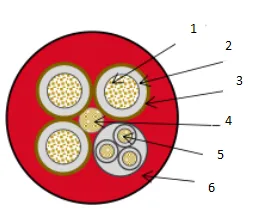Dec . 07, 2024 15:20 Back to list
flanged butterfly valve
Understanding Flanged Butterfly Valves A Comprehensive Overview
Flanged butterfly valves are pivotal components in various industrial applications, particularly in fluid handling systems. Their design and functionality make them ideal for regulating the flow of liquids and gases in pipelines. This article delves into the characteristics, working principle, advantages, and applications of flanged butterfly valves, providing a thorough understanding of this essential valve type.
What is a Flanged Butterfly Valve?
A flanged butterfly valve consists of a circular disc (the butterfly) that pivots within the pipe to control flow. The valve’s flanged connection allows it to be easily bolted to the pipeline, thereby creating a secure seal that minimizes leakage. The disc is connected to a shaft that passes through the center of the valve body, and the position of the disc determines whether the valve is open or closed. When the valve is fully opened, the disc is parallel to the flow, causing minimal resistance; when closed, the disc is perpendicular, completely stopping the flow.
Design and Construction
The design of flanged butterfly valves typically features a streamlined body, which is essential for reducing pressure drops in fluid systems. These valves can be made from various materials, including cast iron, stainless steel, and PVC, allowing them to serve diverse applications based on the nature of the fluid being controlled.
The flanged ends of the valve conform to standard sizes and pressure ratings, ensuring compatibility with pipelines. Installers appreciate this design as it facilitates straightforward assembly and disassembly, thus simplifying maintenance and replacement.
Operating Principle
The operating principle of a flanged butterfly valve is relatively simple. An actuator, which can be manual, electric, or pneumatic, controls the rotation of the butterfly disc. The actuator is connected to the shaft of the valve and can rotate the disc 90 degrees, transitioning from fully open to fully closed positions.
When the actuator turns the disc to an open position, the flow of fluid passes through the valve with little obstruction. Conversely, turning the actuator in the opposite direction closes the valve, and the disc effectively blocks the flow. This straightforward design allows for rapid operation, making butterfly valves suitable for on/off and throttling applications.
Advantages of Flanged Butterfly Valves
flanged butterfly valve

1. Compact Design Flanged butterfly valves are generally more compact than other valve types, such as gate or globe valves. Their slim profile makes them ideal for installations where space is limited.
2. Lightweight Compared to other valve designs that can be heavy and cumbersome, butterfly valves tend to be lighter, reducing the stress on pipeline supports and installation costs.
3. Low Pressure Drop The streamlined flow path of butterfly valves ensures minimal pressure loss, which is crucial in maintaining system efficiency.
4. Versatility Flanged butterfly valves can handle a variety of fluids, whether they are gaseous or liquid, making them versatile for numerous applications, including water treatment, HVAC systems, and chemical processing.
5. Ease of Maintenance With fewer moving parts and a simple design, maintaining flanged butterfly valves is more straightforward compared to other valve types, leading to lower operational downtime.
Applications of Flanged Butterfly Valves
Flanged butterfly valves find applications across multiple industries. In water treatment plants, they control water flow and manage the distribution of effluents. In the oil and gas industry, these valves serve crucial roles in pipeline systems, allowing operators to manage flow rates effectively. Furthermore, HVAC systems utilize butterfly valves to regulate airflow, enhancing energy efficiency.
In chemical processing, the robustness of flanged butterfly valves enables them to handle corrosive substances, ensuring safety and integrity in operations. Their modular design also allows them to be integrated into automated systems, further enhancing control over fluid dynamics.
Conclusion
Flanged butterfly valves are integral to modern fluid control systems. Their unique combination of design efficiency, operational ease, and adaptability to various applications makes them an invaluable asset in a wide range of industries. Understanding their functionality and advantages enables engineers and technicians to make informed decisions when selecting the appropriate valve for their specific needs, ultimately contributing to the efficiency and reliability of industrial processes. As industries continue to evolve, the role of flanged butterfly valves in managing fluid dynamics will undoubtedly remain significant.
Share